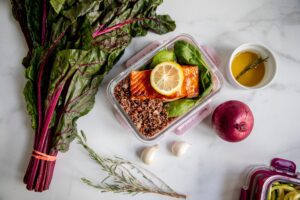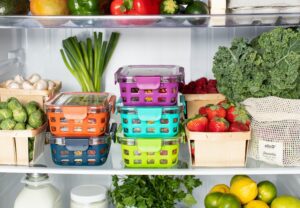November 24, 2023
Meal planning is a key component of a healthy lifestyle, but it can also feel overwhelming, time-consuming, and difficult to sustain long term. In this post, we’ll break down the art of meal planning into easy-to-follow steps, so you can save time and money on food while improving your health.

Step 1: Set Your Goals
Before you start meal planning, it’s important to set your goals. Do you want to lose weight, build muscle, eat more whole foods, or simply be more intentional about your food choices overall? Once you know what specific goals you’re working towards, you can tailor your meal plan accordingly, and you can go to the grocery store with a list in hand.
Setting goals can also help you determine how much food you’ll need to prepare in advance. For example, if you’re trying to lose weight, you’ll likely need to eat fewer calories than you burn each day, but you may also plan to increase your protein intake while reducing your refined carbohydrates in favor of whole-food energy sources. This gives you a strong starting point so you’ll know exactly what to have on hand when it’s time to meal prep.
Step 2: Choose Your Recipes
Once you’ve set your goals, it’s time to choose your recipes. Look for recipes that align with your goals and that you enjoy eating. Don’t be afraid to mix things up and try new recipes!
When selecting recipes, consider the ingredients you have on hand and the season. For example, if it’s summer, you may want to include more salads and fresh fruits in your meal plan. In the winter months, you may wish to opt for more cooked, comfort foods, such as soups and stews.

A great tip is to keep a binder in your kitchen to help you plan your meals each week. Save all of the recipes that you try and love, and keep a list of easy snacks that align with your goals (For example: Plant-based snacks, whole-food snacks, or protein-rich snacks!). When it’s time to go grocery shopping, you can choose a handful of extra snacks to keep in the fridge and pantry so you always have some balanced, grab-and-go options available as needed!
Step 3: Make Your Grocery List
With your recipes in hand, it’s time to make your grocery list. Take inventory of what you already have in your fridge and pantry, then make a list of the ingredients you’ll need to buy at the store for the week.
It can be helpful to organize your grocery list by section of the store (produce, bakery, meat, dairy, etc), so you can quickly and efficiently find what you need. This can save you time, keep you focused, and reduce the chance of making too many impulse buys along the way.

Step 4: Prep Your Meals
Once you’ve purchased your groceries, it’s time to prep your meals. Set aside some time each Sunday to prep your meals for the week. This doesn’t mean you have to cook everything in advance, but small efforts made on Sunday, such as washing, drying, and chopping all of your produce, cooking your grains, and marinating your proteins can make a world of difference when it comes time to make dinner at night. And of course, you can fully cook and prepare some things and store them in air-tight containers to simply grab and go.
Having prepped meals can save time during the week, and make it so much easier to stick to a meal plan that aligns with your goals. You can even make double batches of certain dishes and freeze them for later, or prepare “dump dinners,” where you put all of the raw ingredients for a meal in a freezer-safe container, then simply take it out of the freezer the morning you plan to eat it for dinner and dump it right in the slow cooker so it’s ready when you get home from work.
Step 5: Store Your Meals
With your meals prepped, it’s time to store them. Use glass containers to store your meals in the fridge or freezer whenever possible, as plastic containers can leach chemicals like dioxin, which are toxic to humans. This will help keep your meals fresh and prevent any spills or leaks. Mason jars are great for freezing extra soups, stews, or sauces, but be sure to use a wide-mouth jar when freezing, as the narrow-mouth jars will crack when thawing.

Label each container with the date and contents, so you can easily keep track of what you have on hand. You can also use reusable labels to reduce waste.
Step 6: Enjoy Your Meals
The final step in the art of meal planning is to enjoy your meals! Take time to savor each bite and appreciate the effort you put into meal planning. With a little bit of preparation and organization over the weekend, you can save time, money, and improve your health throughout the week!
By following these steps, meal planning can become a fun and rewarding part of your healthy lifestyle. It can also help you save money on groceries and reduce food waste every week. So why not give it a try? Your body (and your wallet) will thank you for it!


